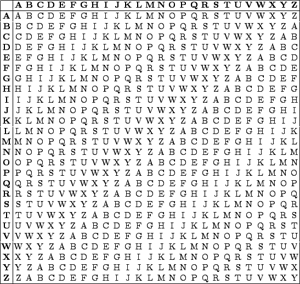In a Caesar Cipher, each letter of the alphabet is shifted along some number of places; for example, in a Caesar cipher of shift 3, A would become D, B would become E and so on. The Vigenere cipher consists of using several Caesar ciphers in sequence with different shift values.
 To encipher, a table of alphabets can be used, termed a tabula recta,
Vigenère square, or Vigenère table. It consists of the alphabet written
out 26 times in different rows, each alphabet shifted cyclically to the
left compared to the previous alphabet, corresponding to the 26
possible Caesar ciphers. At different points in the encryption process,
the cipher uses a different alphabet from one of the rows. The alphabet
used at each point depends on a repeating keyword.
To encipher, a table of alphabets can be used, termed a tabula recta,
Vigenère square, or Vigenère table. It consists of the alphabet written
out 26 times in different rows, each alphabet shifted cyclically to the
left compared to the previous alphabet, corresponding to the 26
possible Caesar ciphers. At different points in the encryption process,
the cipher uses a different alphabet from one of the rows. The alphabet
used at each point depends on a repeating keyword.For example, suppose that the plaintext to be encrypted is:
ATTACKATDAWNThe person sending the message chooses a keyword and repeats it until it matches the length of the plaintext, for example, the keyword "LEMON":
LEMONLEMONLEEach letter is encoded by finding the intersection in the grid between the plaintext letter and keyword letter. For example, the first letter of the plaintext, A, is enciphered using the alphabet in row L, which is the first letter of the key. This is done by looking at the letter in row L and column A of the Vigenere square, namely L. Similarly, for the second letter of the plaintext, the second letter of the key is used; the letter at row E and column T is X. The rest of the plaintext is enciphered in a similar fashion:
Plaintext: ATTACKATDAWN Key: LEMONLEMONLE Ciphertext: LXFOPVEFRNHR
Decryption is performed by finding the position of the ciphertext letter in a row of the table, and then taking the label of the column in which it appears as the plaintext. For example, in row L, the ciphertext L appears in column A, which taken as the first plaintext letter. The second letter is decrypted by looking up X in row E of the table; it appears in column T, which is taken as the plaintext letter.
A Gronsfeld cipher is identical to the Vigenere cipher with the exception that only 10 rows are used which allows the keyword to be a number instead of a word.
A Beaufort cipher uses the same alphabet table as the Vigenère cipher, but with a different algorithm. To encode a letter you find the letter in the top row. Then trace down until you find the keyletter. Then trace over to the left most column to find the enciphered letter. To decipher a letter, you find the letter in the left column, trace over to the keyletter and then trace up to find the deciphered letter.
An Autokey cipher is identical to the Vigenère cipher with the exception that instead of creating a keyword by repeating one word over and over, the keyword is constructed by appending the keyword to the begining of the actual plaintext message.
A Running Key cipher is identical to the Vigenère cipher with the exception that the keyword is chosen to be a book or long passage.










.jpg)
.jpg)

.jpg)





0 comments:
Post a Comment
Note: Only a member of this blog may post a comment.